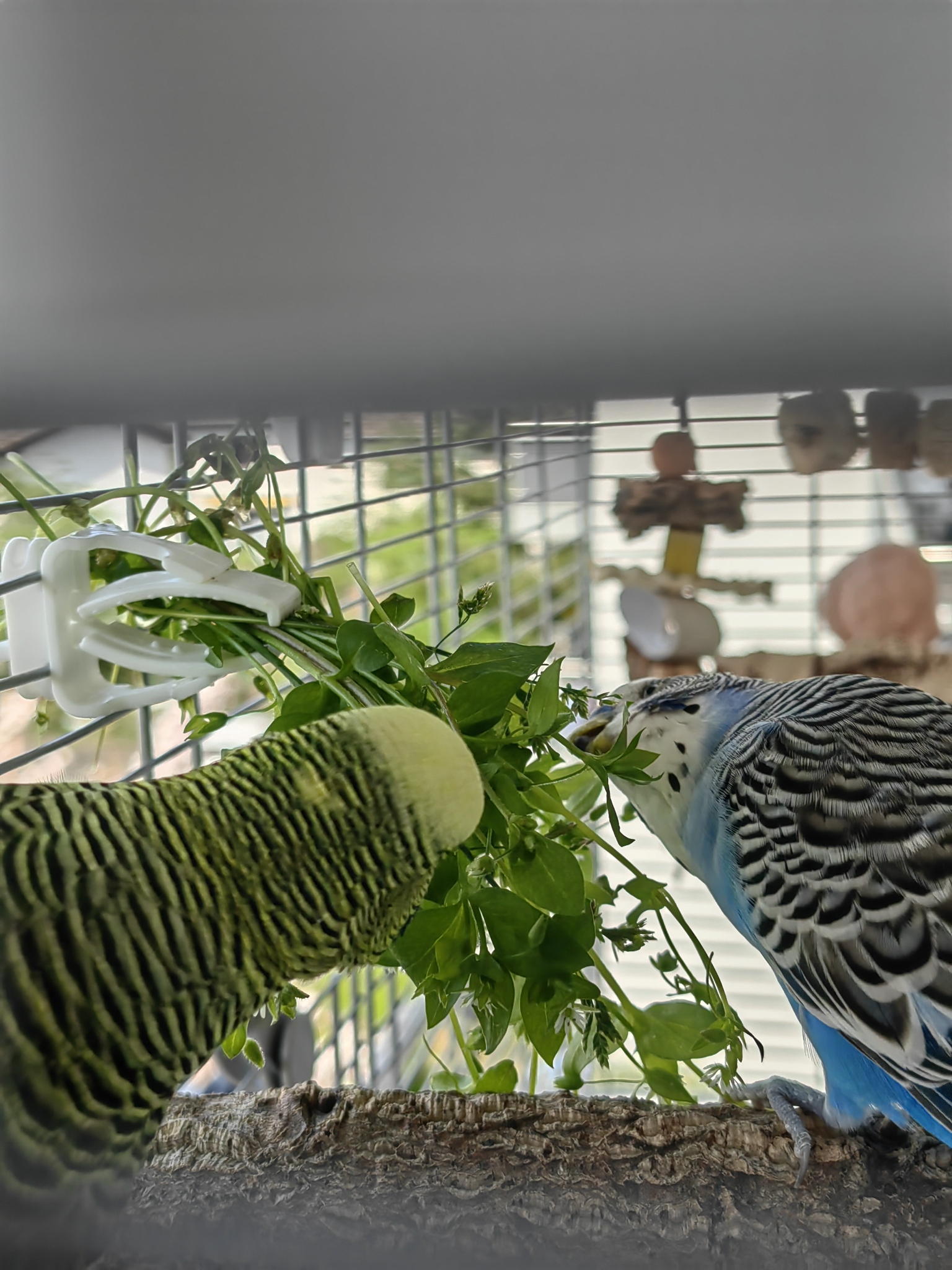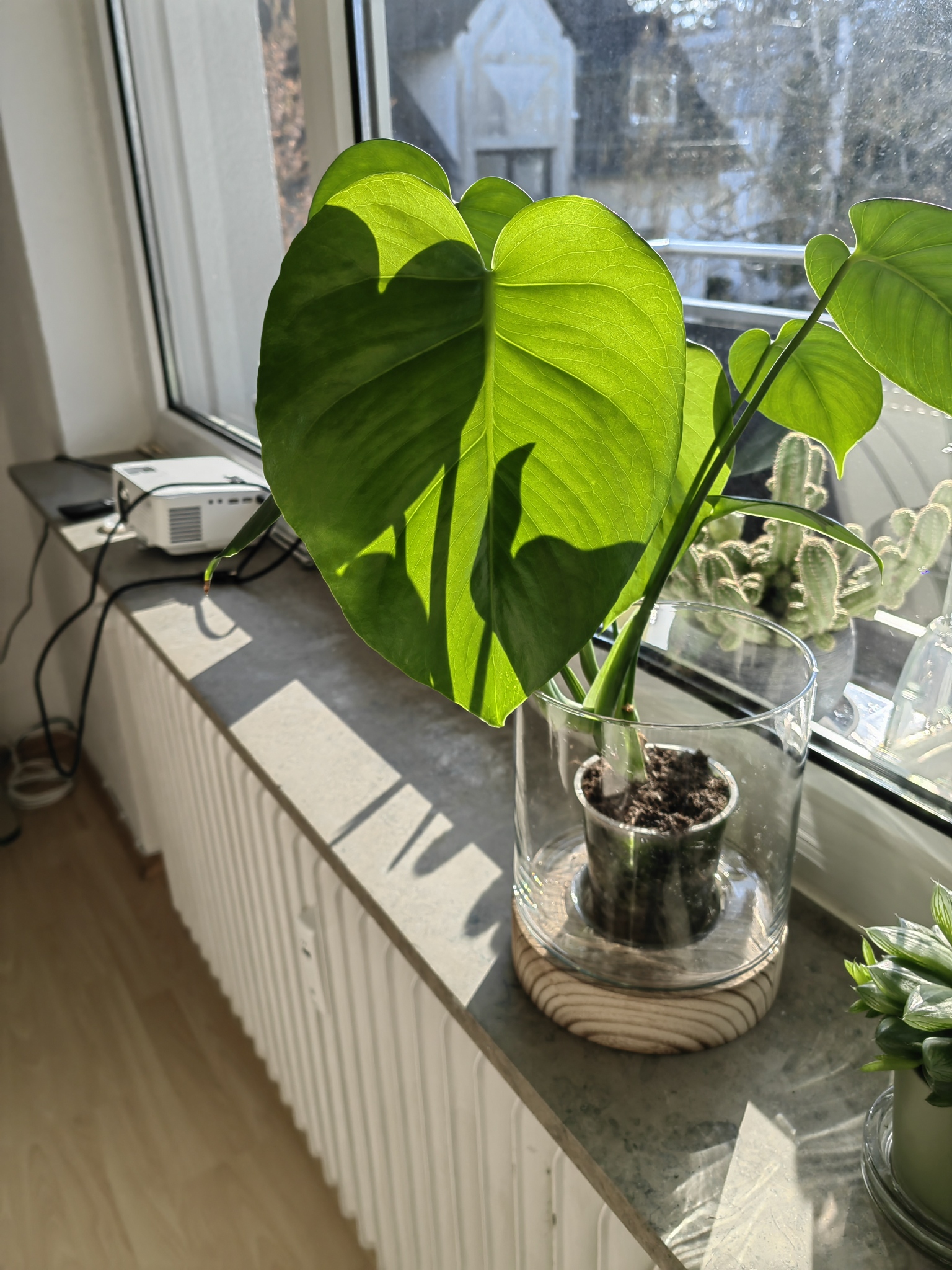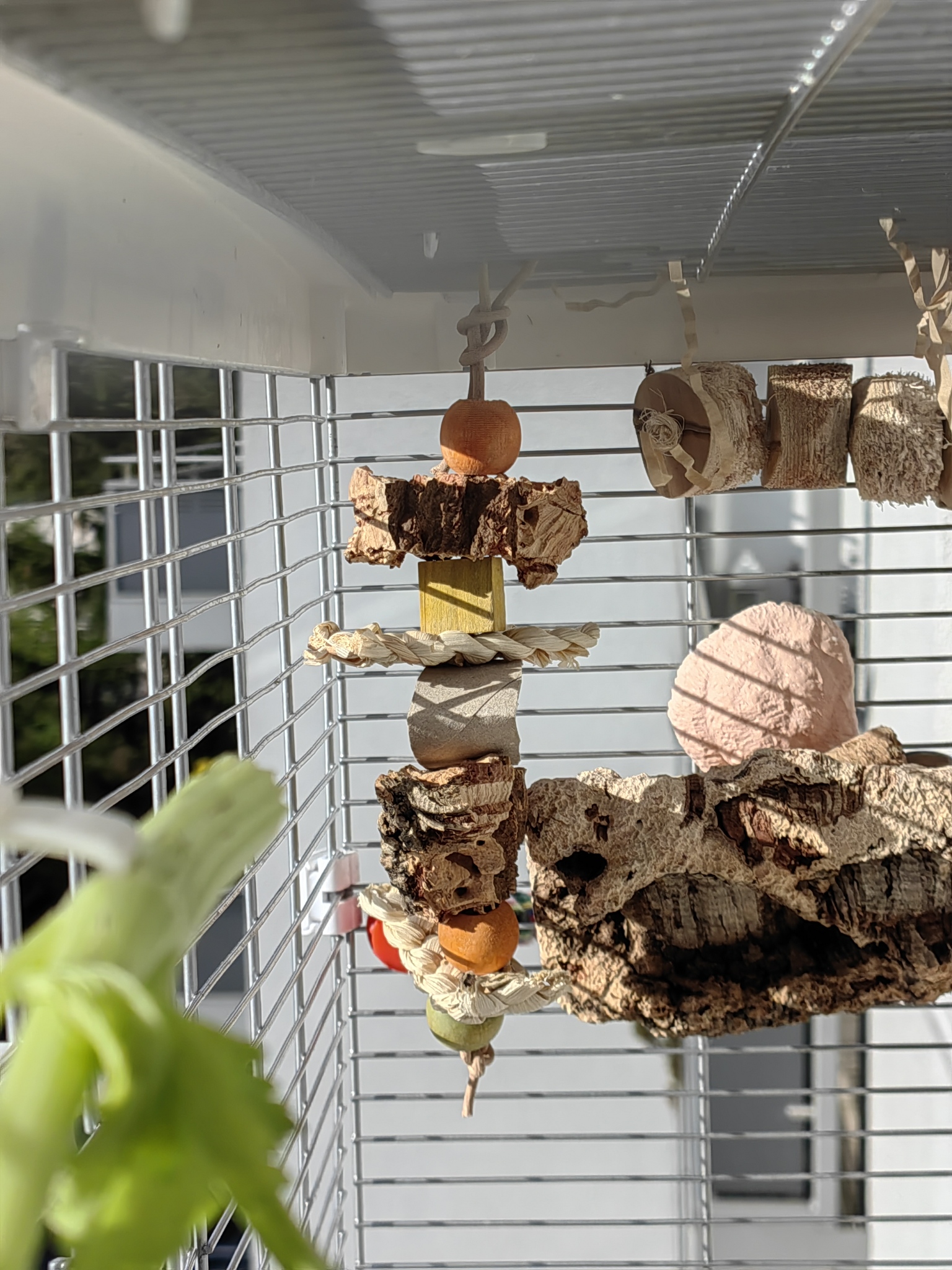A budgie, also known as a parakeet, is a small, colorful species of bird that belongs to the parrot family. Budgerigars are the sole species of the genus Melopsittacus. They are native to Australia and are popular as pets due to their social and interactive nature. Budgies are known for their vibrant plumage, which comes in a variety of colors, including green, blue, yellow, and white, among others. They are also known for their ability to mimic human speech and other sounds, although not all budgies will learn to do this. Budgies aren't low-maintenance birds however they make great companions for those who are willing to provide them with proper care and attention. These colorful birds have been bred in captivity since the 18th century and are the most popular avian pet globally. Budgies are sociable, well-natured, intelligent, easy to train, and capable of advanced vocal mimicry, which further enhances their appeal as a pet.
How long do budgies live?
Pet budgies can live for up to 15 years, but 6 to 12 is a more reasonable range. This is nearly triple their lifespan in the wild, which is just around 6 years. Some breeds of pet budgies such as the English budgies live for just 6 to 9 years.
How long does a budgie live in the wild?
Wild budgies are found in the grasslands of Australia. This really is quite a harsh habitat, with prolonged droughts which last for months and plenty of predators. To stay safe and be able to find food and water, budgies form flocks whenever they can find other members of their species. They move around nomadically. A wild budgie won’t live as long as a domestic one will, therefore they start breeding early in life (9 months - 1 year) and will produce offspring whenever the rainy season rolls around.
How long does a budgie live in captivity?
A captive budgie doesn’t face many of the dangers that its wild counterpart does due to the lack of predators and droughts. It’s dependent on its owner’s care, thus bad bird husbandry is a rampant issue. Budgies are seen as more disposable pets than cats or dogs, with many of them stuffed in unsuitable cages and fed low-quality food. The truth is budgies aren’t low-maintenance pets. They are really fragile birds that need extensive care and a lot of attention. A well-cared-for budgie can live for over ten years. In fact, they can make it all the way up to 15 or even 20 in lucky cases. The oldest budgie on record, named Charlie, lived in the UK from 1948 to 1977. It was 29 years old when it passed away!
Do male or female budgies live longer?
Breeders and experienced keepers report that female budgies can live slightly longer than males, but only by a few months.
What are the predators of budgies?
In their native Australian habitat, budgies are predated by goshawks, falcons, Wedge-tailed eagles, and owls. In addition, red foxes, snakes, and other reptiles predate budgies on land.
How do most budgies die?
Most well-kept budgies die from old age. These include infections, organ failure, and sepsis. In addition, old budgies are particularly vulnerable to disease. Stress also significantly impacts a budgie’s lifespan, so they shouldn’t be exposed to loud noises and other pets. Budgies are fragile animals that require constant care and vigilance to protect them from stressors and toxins.
What is the life cycle of a budgie?
- Incubation time: 18 to 23 days
- Time to fledging: 30 to 40 days
- Juvenile stage: 4 months to 1 year
- Sexual maturity: 8 months to 1 year
- Lifespan (wild): 4 to 6 years
- Lifespan (in captivity): 5 to 15 years
The life expectancy of a budgie is highly dependent on how well it’s looked after.
A healthy diet and ideal living conditions extend your budgie’s lifespan
Budgies can live well in captivity if they are provided with a suitable living environment and proper care. Budgies are social birds and thrive on interaction and stimulation, so it's important to provide them with toys and opportunities to fly and exercise. They also require a nutritious and varied diet that includes a mix of seeds, pellets, and fresh fruits, vegetables and herbs. A nutritious and healthy diet helps in increasing their life span. You can feed them vegetables every day, I personally feed my birds leafy greens every day. They get fruit once in two weeks (due to their high fructose levels). The only occasion I recommend giving them vitamins is during the molting season and when young budgies are fledging. However, read the instructions carefully before feeding it to your budgies as too much can cause hypervitaminosis. They should be given fresh mineral water daily (no tap water), and avoid placing the tray below the seed pan or bird feeder to avoid floating seeds and poop landing into their water. If you wish to increase the life expectancy of your budgies, make sure you give them a healthy diet and keep their environment clean. Learn more about the ideal budgie diet here.
When kept in captivity, it's important to ensure that the cage is large enough for the bird to move around freely and that it is kept clean and free from potential hazards. Budgies also require regular interaction and socialization with their owners to maintain their mental and emotional well-being. Learn more about the ideal budgie cage here.
 Budgies eating chickweed.
Budgies eating chickweed.
Teflon cookware and other toxins pose a threat to your bird’s life
I keep highlighting the dangers of Teflon toxicity in all my articles. Teflon is a brand name for a type of non-stick coating that is often used on cookware, such as frying pans. The primary component of Teflon is polytetrafluoroethylene (PTFE), a synthetic polymer that is known for its non-stick properties and high heat resistance. When PTFE is heated to temperatures above 500°F (260°C), it can release toxic fumes that can cause flu-like symptoms in humans and is fatal to birds. This condition is known as polymer fume fever or Teflon flu. In normal household use, Teflon-coated cookware is generally considered safe, provided that it is used and cleaned according to the manufacturer's instructions. It is also important to avoid using metal utensils or abrasive sponges on Teflon-coated surfaces, as this can cause the coating to flake off and potentially be ingested.
Do not smoke tobacco or cigarettes around budgies!! The smoke is toxic to the little bird’s lungs.
House plants are toxic to birds. Plants should never be kept in the same room as your birds. Common house plants can be toxic to birds if ingested.
- Dieffenbachia: This plant, also known as dumb cane, is toxic to both humans and animals if ingested. It can cause swelling, burning, and difficulty swallowing.
- Philodendron: This plant is toxic to birds if ingested, and can cause vomiting, diarrhea, and difficulty breathing.
- Pothos: This popular house plant is toxic to birds and can cause vomiting, diarrhea, and difficulty breathing.
- Sago Palm: This plant is highly toxic to birds and can cause liver failure, seizures, and death if ingested.
- Oleander: This plant is extremely toxic to birds and can cause severe heart problems and death if ingested.
- Monstera
- Calathea
 Monstera is poisonous to birds.
Monstera is poisonous to birds.
It is important to note that this is not an exhaustive list, and there are many other plants that can be toxic to birds. If you have a bird in your home, it is important to research any plants that you plan to have in the same area as the bird to ensure that they are safe for them.
Never clip the bird's wings
It is seen that in order to prevent the budgies from escaping, owners often clip their wings. I am against clipping birds’ wings, it’s similar to cutting off a human’s legs and the bird will end up depressed. Trimming the wing feathers also prevents them from flying off. Flying is the best exercise for budgies, and when they do not receive enough of it, they tend to become fat. If your budgie does not get enough exercise, limit the treats to once in 14 days. If the internal organs of the bird become fat, it will lead to organ failure (fatty liver disease).
Anti-collision window stickers
If you are teaching the bird how to navigate around the house I suggest using anti-collision stickers on the windows to avoid injuries (I suggest buying the black stickers as those are more visible to birds). When I first brought Hatchin home I made sure that each window had a sticker. It worked out he hasn't collided with any of the windows to this day.
The lifespan of a budgie: what influences it?
Breeding and genetics
One very important aspect of the lifespan of a budgie that you, unfortunately, can’t influence is genetics. A lot of this depends on breeding. Some breeders are focused on producing as many budgies as possible for the pet industry and making as much money as they can to keep their business going. They might not examine their stock for problems, which means genetic diseases, as well as birth defects, can run rampant. In order to produce the amazing array of budgie colorations and patterns we know today, breeders have had to select certain traits and breed them back to each other to stabilize their lines. This means breeding birds that are related to each other to make sure the offspring have the desired trait. A certain degree of breeding back is not a problem for the resulting birds’ health, but if breeders take it too far, defects might start to pop up.
English budgies vs wild type
If you’ve ever seen an English budgie, you’ll know it’s quite different from the ‘regular’ wild-type variety. English budgies are much bigger and also sport a larger, fluffy head. The English budgie’s typical appearance was achieved through extensive selective breeding for show and the pet industry. English budgies might not always be around for longer than five and are known to have more health issues. Original green budgies also live longer than their color-mutation counterparts (albinos have the shortest life span and are more prone to disease). These birds are prone to tumors, thus lowering their life expectancy. Many also die due to accidents and mishaps. Thus, never let your little bird out of your sight. Make your home bird-proof. Make sure you do not have any poisonous plants around, or electrical wiring or strings tied in the house that can lead to unfortunate accidents. Budgies should never be kept in the kitchen.
 A perfectly round budgie.
A perfectly round budgie.
Cleanliness
Keeping your bird’s surroundings clean is another essential method to keep it healthy. Unsanitary conditions may develop into a breeding ground for viruses and germs, which can harm your pet if left unchecked. It will also be unpleasant for the bird to be left in a filthy and unorganized cage.
Care
Aside from genetics and diet, there are quite a few more general care factors that will contribute to your budgie’s long-term health and lifespan.
These include but are not limited to:
- Cage size and exercise options
- Clean air (no smoking, perfumes, non-stick pans, candles, etc.)
- Minimal stress (no rough handling, no loneliness, etc.)
- Budgie-proofing the environment if the bird flies free (minimizing dangers)
- Only safe toys (made of wood)

DIY toy I created from cork and recycled old toys.
How old is my budgie?
To conclude this article, you might be wondering how old your budgie is. Now, there are some basic age indicators for these little parrots, but if your bird is an adult then you really won’t be able to tell how old it is exactly unless the breeder ringed the bird or the previous owner happens to remember. If your budgie has a striped head with no “bald” spot (ie. it still has stripes on the top of the head) then it hasn’t molted yet and should be younger than around 4 months. The same applies to most budgies with entirely black eyes and no visible iris; if the iris is light grey or brown then that means your bird is over 8 months old. Now, these age pointers are obviously not foolproof and don’t even apply to all budgie color varieties (some don’t have head stripes, for example). So figuring out your budgie’s age is going to be a challenge and pretty much impossible once it’s over ~8 months in age, but with good care, you’ll hopefully still be able to enjoy its company for years to come.
How long can budgies live without food and water?
Budgies need to be fed every day. They cannot reliably survive more than one day without eating and drinking. If they’re not fed for around 24 hours, budgies can weaken and die rapidly. Budgies also need to drink every day and can die without drinking for 24 hours.
Are budgies endangered?
Budgies are listed as a species of Least Concern by the International Union for Conservation of Nature (IUCN). Their native population is currently stable and increasing.